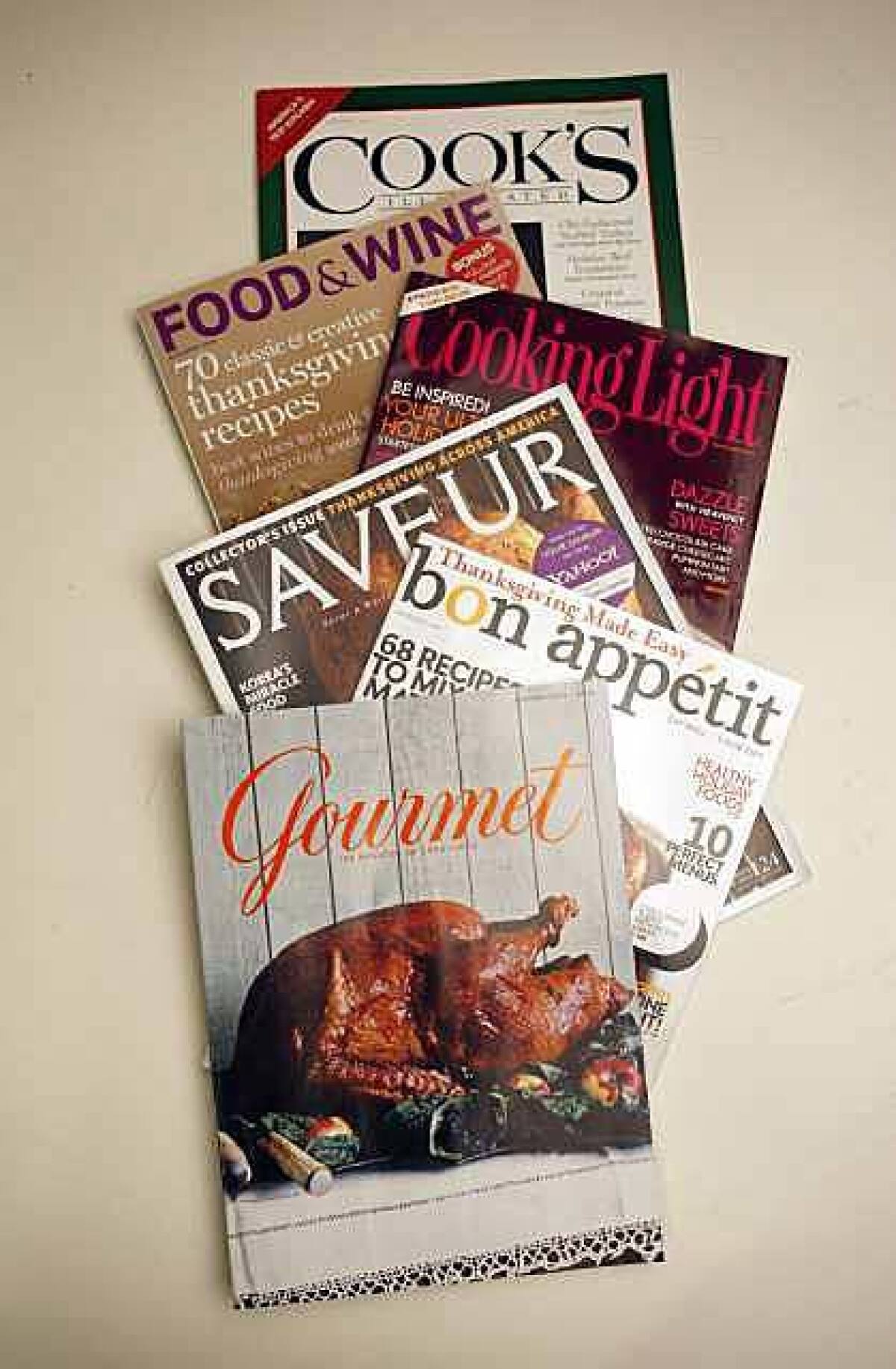Apres Gourmet: Food magazines find their niches

Since Condé Nast shuttered Gourmet magazine a month ago, the world of food publishing has been consumed by postmortems. What went wrong and why? But maybe a more interesting question is: Where do we go from here?
The queen is dead, long live the queen. But which magazine will emerge to take Gourmet’s throne? The answer is, probably none of them.
In looking through the Thanksgiving issues of the various food periodicals now on the newsstands, it becomes clear that more and more magazine publishing is about what broadcasters call narrowcasting -- focusing on serving the needs of a small but enthusiastic audience. In the end, Gourmet may have been done in by trying to do too much, rather than too little.
“Magazines are getting more and more fragmented, and I think we’ll see more and more of that in the future,” says Steve Cohn, a magazine world insider and editor in chief of Media Industry Newsletter. “Big mass magazines are still there, but they’re losing circulation.”
Robert Boynton, director of the literary reportage program at the Arthur L. Carter Journalism Institute at New York University, agrees. “I think of Gourmet closing as part of the bigger story of the demise of the general interest magazine. It was the closest thing the food world had to a Life or Saturday Evening Post. But in publishing today, it has become easier and more profitable to disaggregate or divide up readership into small groups.
“That may be good business, but in the process the whole notion of food itself as a cultural artifact gets lost. And it made it really difficult for a magazine that not only had incredible photography and recipes and editing, but had really, really fine writing.”
Cohn compares it to the way the business of television has changed. “Basically, the magazine world is becoming like cable TV. Everything is narrowcast. When I was a kid, there were three TV networks and everybody watched ‘The Cosby Show’ and ‘All in the Family.’ Now there are a zillion cable channels, with all of these shows you’ve never heard of but that still attract an audience.
“I think we’re only going to see more of this fragmentation. Unfortunately, that seems to match everything else that’s going on these days.”
(At this point, a disclaimer is necessary. It’s impossible to write about food for 25 years and not have personal connections to stumble over in a story like this. Former Gourmet editor Ruth Reichl hired me to work at The Times and remains a friend, as do many editors and writers at other magazines.)
Business decision
Most of the early analysis seemed to blame Gourmet’s closing on one of two factors. Some blamed what they perceive as the magazine’s highfalutin tone for alienating readers. New-media enthusiasts used it as one more example of how print is dead.
But those arguments seem to be contradicted by the facts. In the first place, Gourmet’s circulation was a far-from-pitiful 980,000 -- up almost 100,000 from 10 years ago. That hardly sounds like a magazine readers were running away from.
As for that whole print dinosaur thing, have you looked at the Gourmet website? Video, Web-only stories, lots of art, commentary, lots of reader feedback . . . it’s hard to think of a food website that offers as much.
Reading deep sociological implications into corporate business decisions is always risky. Condé Nast’s decision was almost certainly based a lot more on short-term dollars and cents than on aesthetics or visions of the future.
“It was as much the economics of Condé Nast as the economics of Gourmet that forced the closure,” Cohn says. “It wasn’t a case of Gourmet ‘failing’ as much as Condé Nast having serious trouble on a corporate scale. In a different company, Gourmet would probably still be around. The fundamentals were very good.”
Boynton argues that if Gourmet had a major flaw, it was more likely trying to be a department store in what has become a specialty-store publishing world. It tried too hard to be all things to all people. Recipes? Check. Long, writerly pieces by big-name bylines? Check. Short practical cooking pieces? Check. Travel, both high and low? Check and double-check.
That kind of coverage is expensive, and in a struggling corporation in a tight economy, that may have been enough to doom it.
Discrete audiences
Each of Gourmet’s primary competitors -- Bon Appetit, Cooking Light, Food & Wine, Saveur and Cook’s Illustrated -- has a very specific personality. They are targeted and tightly focused, and for the most part and most of the time, they do what they do extremely well and extremely efficiently.
In broad strokes, Bon Appetit offers recipes with lots of glossy photos to go with them. Cooking Light claims as a mission “Making healthy taste great,” but it takes a much broader view than you might think; after all, its Thanksgiving cover is pecan pie. Saveur specializes in cultural reports on exotic -- or as it prefers, “authentic” -- cuisines. And Cook’s Illustrated aims for culinary wonks with stories tinkering with familiar recipes and Consumer Reports-style testing of ingredients and equipment.
Gourmet tried to do all of these, often in the same issue. And that, Boynton says, may have been its downfall.
“In general, they were still trying to do a little of everything, which is a hard thing to do,” he says. “It’s not that they didn’t do it well, but that they tried to do it all in one place. Everyone today seems to be doing very small things in several different places.”
More to Read
Eat your way across L.A.
Get our weekly Tasting Notes newsletter for reviews, news and more.
You may occasionally receive promotional content from the Los Angeles Times.







